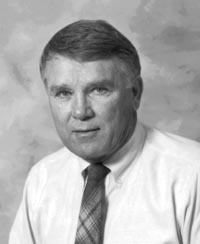In Memoriam: James E. Johnson
1936-2005
by Bob Meyer, Ward Whicker, and Keith Schiager, CHP

Dr. James E. Johnson, native of Warren, Pennsylvania, and former professor at both Colorado State University (CSU) and the University of New Mexico (UNM), died Friday, 11 March 2005, after a long struggle with lung cancer. He was 69.
After completing his BS in chemistry at Houghton College in New York, Jim graduated with a master's degree in health physics from the University of Rochester, working as a research assistant at the university's whole-body counter. He was an Atomic Energy Commission Fellow. He began his Colorado career in health physics in 1962 as an instructor at CSU, soon becoming the institution's radiation safety officer.
In 1964 Jim became director of the whole-body counter laboratory at CSU, working in the departments of Animal Science and Radiological Health Sciences. He attained his PhD from CSU in 1965 and performed postdoctoral research at the Harvard Medical School in 1967 and 1968. His research at CSU during this period involved the movement of fallout 137Cs from the troposphere to man, work funded by the U.S. Atomic Energy Commission.
As an assistant professor in the Departments of Animal Sciences and Radiology/Radiation Biology at CSU from 1965 to 1969, Jim studied the dermal transport of plutonium dimethyl sulfoxide and began research on the deposition and retention of simulated fallout in food crops and animal forage.
In 1969 Jim was certified by the American Board of Health Physics and became an associate professor at CSU, completing the fallout study and beginning work on 210Po metabolism in ruminants. He also began a project at the Rocky Flats Plant located near Boulder, Colorado, evaluating plutonium concentrations and transport in nearby aquatic systems. Jim was a coinvestigator for the pre-event environmental inventory and impact analysis on Project Rio Blanco, one of a series of underground nuclear tests conducted by the U.S. Atomic Energy Commission for stimulating natural gas recovery from geological formations of low permeability.
In 1974 Jim was promoted to full professor at CSU, and during the same period he became principal investigator for the environmental radiation surveillance project at the Fort St. Vrain high-temperature gas-cooled reactor. In 1981 he began a five-year investigation for the U.S. Department of Energy to confirm milk and meat radionuclide transfer coefficients. He was a key contributor to the overall development of the department and its graduate program, particularly in the areas of radiochemistry, whole-body measurements, and practical health physics.
In 1991 Jim became a research professor in the Department of Chemical and Nuclear Engineering at UNM in Albuquerque, publishing research on Chernobyl fallout environmental transport, including the human food chain.
He authored or coauthored more than 50 peer-reviewed papers during his career on topics ranging from fallout environmental transport to plutonium distribution and movement in the environment to the concentration of plutonium in bacteria from aqueous media. During his teaching career at CSU and UNM, Jim advised many graduate students who have since made significant contributions to the field of health physics. Jim was active in the Central Rocky Mountain Chapter of the Health Physics Society, serving a term as chapter president in the 1970s. He was professionally known both nationally and internationally. He spent a year at the GSF-Forschungszentrum für Umwelt und Gesundheit in Neuherberg, Germany, where he worked with several leading European scientists in the field of environmental radiation protection.
Jim was an avid and accomplished skier, tennis player, and golfer. He also loved bicycling and auto mechanics. He had a large number of close friends, many of whom were professional colleagues and graduate students. He built a log cabin in the Colorado Rockies and enjoyed many memorable days there with family, students, and friends. Jim had a flair for adventure, friendly competition, and good times with all who knew him well. His optimistic and fun-loving nature will be long remembered.
He leaves his wife, Sharon, his first wife, Janet, and their families, including five children and 10 grandchildren.




